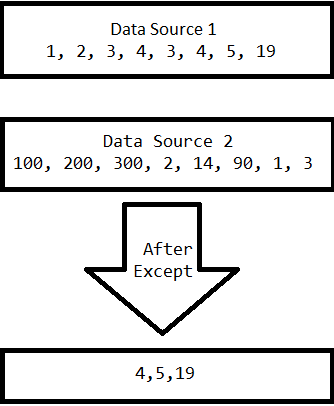Set Operation in LINQ
Written By:- Isha MalhotraWhat is Set Operation
We use following set operations in LINQ:-
Distinct
Distinct remove redundancy and show the unique records.
 Figure 1
Figure 1
Example of Distinct
int[] techaltum = { 1, 2, 3, 4, 3, 4, 5, 19, 89, 4, 8, 2 };
IEnumerable<int> res = techaltum.Distinct();
Response.Write("Result after Distinct <br/>");
foreach (int data in res)
{
Response.Write(data+"<br/>");
}
The output of this code as follows:-
 Figure 2
Figure 2
Except
Except operator returns those values from first data source which do not repeated in second data source.
 Figure 3
Figure 3
Example of Except
int[] techaltum1 = { 1, 2, 3, 4, 3, 4, 5, 19 };
int[] techaltum2 = { 100, 200, 300, 2, 14, 90, 1, 3 };
IEnumerable<int> res = techaltum1.Except(techaltum2);
Response.Write("Result after Except <br/>");
foreach (int data in res)
{
Response.Write(data+"<br/>");
}
The output of this code is as follows:-
 Figure 4
Figure 4
Note: - except will not return those value which not in first data source but in second data source.
DataContext dc = new DataContext("Data Source=.;Initial Catalog=TechAltum;Integrated Security=True");
//sum without condition
int sum_without_cond = dc.GetTable<Class1>().Sum(prod_sum => prod_sum.no_of_prod);
//sum with conditon
int sum_with_cond = dc.GetTable<Class1>().Where(cond => cond.prod_year == 2001).Sum(prod_sum => prod_sum.no_of_prod);
Response.Write("Sum without conditon=" + sum_without_cond + "<br/>");
Response.Write("Sum with conditon=" + sum_with_cond + "<br/>");
Intersect
Intersect returns those values which are common in both data Source.
 Figure 5
Figure 5
Example of intersect
int[] techaltum1 = { 1, 2, 3, 4, 3, 4, 5, 19,100 };
int[] techaltum2 = { 100, 200, 300, 2, 14, 90, 1, 3 };
IEnumerable<int> res = techaltum1.Intersect(techaltum2);
Response.Write("Result after Intersect <br/>");
foreach (int data in res)
{
Response.Write(data+"<br/>");
}
Output of this code:-
 Figure 6
Figure 6
Union
It will show the sequence value of two data source.
First it will show values of first data source and then second data source but it shows repeated value only one time.
 Figure 7
Figure 7
Example of Union
int[] techaltum1 = { 1, 3, 4 };
int[] techaltum2 = { 2, 200,3, 300,14 };
IEnumerable<int> res = techaltum1.Union(techaltum2);
Response.Write("Result after Union <br/>");
foreach (int data in res)
{
Response.Write(data+"<br/>");
}
Output of this code:-
 Figure 5
Figure 5
Email Address
For any query you can send mail at info@techaltum.com
Thanks